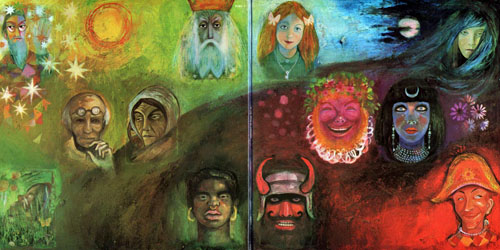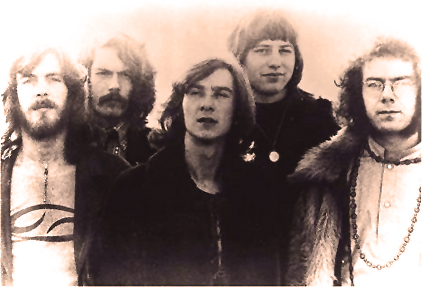Considering that the only constant within King Crimson was change, the quality of their early albums is, in hindsight, even more remarkable. Poised to conquer the world, or at least own the underground, following the release of In The Court of the Crimson King(1969)—easily one of the enduring debut records in all of rock—the band instead almost imploded. Singer/bassist Greg Lake abruptly headed off for proggier pastures, joining up with Keith Emerson and Carl Palmer to begin a decade-long quest of driving snooty critics insane. Equally distressing was the departure of multi-reedist/composer Ian McDonald, whose input was indelible on the first album.
Robert Fripp, the acknowledged mastermind and reticent leader, was now completely in control as a new decade commenced. On one hand, he had material ready to record; on the other hand, he did not have a band. Somehow, he managed to convince Lake to stick around long enough to lay down some vocal tracks along with the Giles brothers (drummer Michael and bassist Peter). Rounding out the personnel was Keith Tippett (piano) and Mel Collins (sax, flute), both of whom would figure prominently in the band’s subsequent albums.
The line-up shuffling would continue and turned out to be a considerable blessing, as each album King Crimson made sounds distinct and unconnected. This is actually a fairly unique phenomenon, particularly within the progressive rock movement. Where bands like Genesis and Yes slowly built up confidence and momentum, eventually hitting on all aesthetic cylinders (on albums like Close to the Edge and Selling England By the Pound), King Crimson released individual statements of purpose. As a result, there is no other band that, in the span of 4-5 years, made such radically different yet satisfying records.
In The Wake of Poseidon manages to be many things, most of them quite good, and in the end is greater than the sum of its puzzling pieces. Naysayers have pointed out that it could be considered a paint-by-numbers impression of the first album. There is a foundation for this critique, but it does not take into account that the follow-up remains at once more and less than the more universally worshipped debut. Even though In The Court of the Crimson King seems to exist uncannily out of time (it could only have been recorded in the hippie hangover of ’69, but it also still seems somehow ahead of its time), In The Wake of Poseidon is more of a prog-rock period piece, a distinctive document of a type of music that is not made any longer.
For haters, or people who can’t or won’t bring themselves to give the music of this era the scrutiny and approbation it deserves, progressive rock seems best remembered as a noisy splash that left its pretentious imprint (sonic dinosaur fossils, if you will) and then got sucked out to sea once the restorative tide of punk rolled in. For such folk, the notion of a 40th anniversary special edition reissue (double-disc, no less) might seem like either a waste of resources or a typically gluttonous cash grab. The former sentiment cannot be helped, but the latter should be addressed.
These albums found, and continue to find their audience because of the simple fact that they are convincing and consistently rewarding after the first dozen (or thousand) listens. That noted audiophile and/or fanatic Steven Wilson, of Porcupine Tree, was game to revisit the vaults and diligently produce a 5.1 surround sound mix tells you some of the tale. Groups like King Crimson were not just obligatory reference points for young musicians to absorb; their conceptual bent and refined aesthetic remain touchstones of influence and inspiration. Of all the prog-rock bands, Crimson might have the market cornered on innovation and integrity: there was nothing about any of their albums that gave even a modicum of attention to commercial or critical concerns. People who dislike progressive rock consider this the reason; people who endorse it find this the only evidence required in its defense.
Even for ardent Crimson fans, In The Wake of Poseidon has presented problems. For starters, it would simply be impossible to improve upon the perfection of the debut, so the second effort was invariably going to disappoint some listeners. The aforementioned structural similarities, although overblown, are difficult to overlook as well. On side one of each album, there is the frenetic, dark side of society opener followed by a gentle ballad and then an earnest (or lugubrious) statement at the end. Perhaps it’s personal preference, but I’ve always found “Pictures of a City” (which comes crashing out of the scarcely-audible tone poem “Peace—A Beginning”) more consistently awe-inspiring than “21st Century Schizoid Man”, and I consider “In The Wake of Poseidon” even better than the incredible “Epitaph” from the debut. “Cadence and Cascade” suffers unfairly when compared to Ian McDonald’s majestic “I Talk To The Wind”, but it is still sublime: the cymbal sprays and Mel Collins’ ethereal flute are as gorgeous as anything else from this era (Gordon Haskell’s vocals, weird and unsettling on the next album, Lizard, here are weird but wonderful).
The sound on the first disc is the 2010 mix, and it is a definite improvement on the (already sufficiently spectacular) previous reissue; the sound on the bonus 5.1 mix is even more of a revelation. For fans, like myself, who have heard these albums on vinyl, or cassette, or earlier digital pressings, it actually is worthwhile to hear sounds long-buried in inferior mixes. The clarity is, frankly, astonishing, and any fans that have the first edition of this disc will be delighted with the upgrade. As always with a proposition like ostensibly superfluous reissues, it’s the subtle elements that make a difference: on the title track, every single acoustic strum is crystalline but not at the expense of the other instruments; each sound, from the bass to the drums (which, on this track, function sort of like a lead guitar—out in front and pulling the song forward), to Greg Lake’s voice — never in better form than on the first two Crimson releases. The urgency of the music (and its messages) is appropriately stark, and it really does seem almost like the band is playing live in your living room.
The second side is where, stylistically, the album suffers a bit. The individual songs are excellent in their own way(s), but going from the funereal mellotron that concludes the title track into the idyllic “Peace — A Theme” (one of Fripp’s most unaffected but affecting compositions) does not exactly set the scene for what follows. “Cat Food” is obviously a lark, and even though the musicianship is typically first-rate, it is a tad jarring considering what has come before (Better the band should have gone with outtake “Groon”, an aggressive and ominous instrumental barnburner and left “Cat Food” as the non-album single — particularly since it actually charted).
Album centerpiece “The Devil’s Triangle (Parts 1-3)” is an unacknowledged riff on Holst’s classical piece “Mars” (from Planets), functioning as a descent even further into the abyss, following the title track that concludes the first album. Clearly this was the one Melody Maker had in mind when they suggested, in 1970, “If Wagner were alive, he’d work with King Crimson.” Nonsense like that makes it a little more understandable why this era was difficult for so many to stomach. Featuring more mellotron than most bands could conceivably cram into a double album, “The Devil’s Triangle” utilizes a drum and bass march, balancing dread and release with wind effects and jarring foghorn cries. Adore it or detest it, most honest listeners would concede that few bands did beauty and horror quite like King Crimson. The tension implodes on itself, segueing into the soothing “Peace — An End”, which functions like the sun coming out after a thunderstorm.
All in all, this is an album that holds up quite nicely and is dated only in the sense that it sounds like it was made in 1970, and 1970 was a very nice year indeed for the making of albums. So where does that leave us? The extra disc and assorted out-takes and remixes will gratify the die-hard contingent; this might all be a bit much for the merely curious or those unlikely to be intrigued. It is, essentially, what it is: a welcome reissue that enables anyone and everyone to hear a classic prog statement in a new light and possibly be transported to a time when albums were as serious as the musicians who made them — for better or worse.


